20876 ACE Language (Yr 1) Simple Texts
You also want an ePaper? Increase the reach of your titles
YUMPU automatically turns print PDFs into web optimized ePapers that Google loves.
Text structure<br />
and organisation<br />
Understand patterns of repetition and contrast in simple texts<br />
(<strong>ACE</strong>LA1448)<br />
© Australian Curriculum: Assessment and Reporting Authority 2012<br />
Activities to<br />
develop the<br />
content description<br />
E1. Identifying patterns of words including smaller groups relating to larger groups, words which<br />
relate to topics as a whole, words which compare or contrast topics in a text, words which show<br />
cause and effect, words or phrases which are connected by repetition throughout a text, or words<br />
which usually occur together.<br />
• Repetition in texts (pages 30 to 36)<br />
During shared, home or free reading, expose the students to a variety of texts which include repetition used in various ways. These could include<br />
repeated use of the name of a character in a story (Harris the helicopter—page 30), repeated sentence structure (Eating, working, playing and<br />
sleeping—page 31), repeated use of sounds as alliteration (Ten tiny tigers—page 32), repeated rhymes in a poem (The four dragons—page<br />
33), repeated use of verbs to begin steps in a procedure (Magic trick—page 34), repeated chorus after a verse in a song (I’m a nut—page 35), or<br />
repeated call and response (The littlest worm—page 36). Repetition helps students link ideas in a text.<br />
• Contrast in texts (pages 37 to 45)<br />
– Why the whale spouts and the starfish looks ragged (page 37)<br />
Read texts such as the one provided with the students and ask them (in simple terms) to<br />
identify words which connect ideas in a text which show cause and effect. Examples<br />
include words such as ‘because’,’so’, ‘since’, ‘consequently’, ‘due to’, ‘owing to’, ‘because<br />
of this’ etc. These ‘text connective’ words give cohesion to stories and poems and may<br />
include grammar such as conjunctions.<br />
– At the pet shop/On the farm (page 38)<br />
Ask the students to identify, by circling or underlining words in a simple<br />
text relating to a topic, to show connections between words. Use<br />
separately or together.<br />
– Word card sorts (pages 39 and 40)<br />
Play games which ask the students to sort word cards into smaller<br />
groups relating to a topic or theme. Page 39 includes land, sea and<br />
air transport; page 40 includes names of sports/games, equipment<br />
and people involved in sports.<br />
– Whose home am I? (page 41)<br />
Read and ask the students to identify words which are parts of a<br />
topic. Later, as students write longer texts, these words may form<br />
the basis for information in a paragraph. In the text provided on<br />
page 41, the students will identify words relating to homes—walls,<br />
fl oor, roof, door, window, garden, neighbourhood etc.<br />
– Animals move/The opposites story (pages 42 and 43)<br />
Expose students to the use of literary devices such as synonyms (similar meaning words) and antonyms (opposites) and discuss how they relate to<br />
other words in the text.<br />
– Hey little fly!/How the first butterflies were born (pages 44 and 45)<br />
Read texts which show connections between opposing viewpoints (page 44) such as in persuasive texts, or different imagery in poetry (page 45). The<br />
poem on page 44 is loosely based on the story Hey, little ant by Phillip Hoose.<br />
Interrelated English links: See page 53<br />
E2. Discussing different text types including stories and poetry and identifying their features including<br />
language patterns and repetition.<br />
• Loawnu the wise woman/A monster of a machine/Make a healthy snack (pages 46 to 51)<br />
Encourage students to look closely at texts for particular language features to help them better understand concepts about texts. Constant exposure also<br />
provides devices which students could employ in their own writing. <strong>Simple</strong> text examples have been provided including a narrative (Loawnu the wise<br />
woman), poem (A monster of a machine) and a procedure (Make a healthy snack) with corresponding language features checklists. <strong>Language</strong><br />
features can include sentence structure, vocabulary, punctuation and fi gurative language as well as illustrations, diagrams and graphics. (ACARA glossary<br />
page 75) NOTE: This section does not include text structure which is covered in <strong>ACE</strong>LA1447.<br />
Interrelated English links: See page 53<br />
R.I.C. Publications ® www.ricpublications.com.au Australian Curriculum English – <strong>Language</strong>: Text structure and organisation (Year 1)<br />
29


















